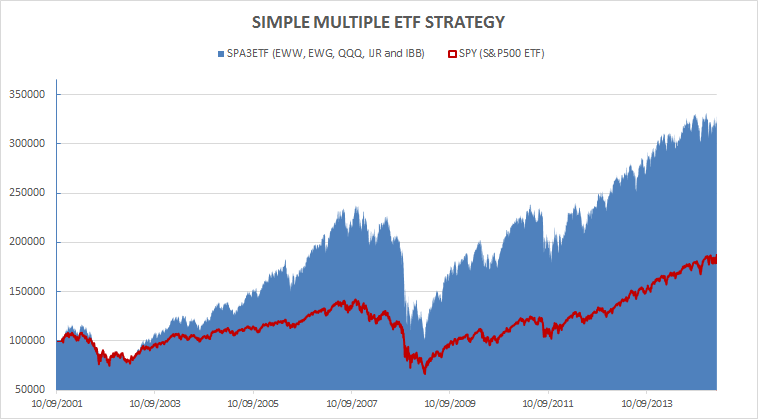Returning to our series on ETFs and how as active investors and traders we can use them to not only be our own fund manager, but also to out-perform the vast majority of fund managers, this week we take a look at a multiple ETF strategy.
This simple multiple ETF strategy builds on the single ‘buy and hold’ ETF strategy. Instead of holding just one ETF, typically an Index tracking ETF, this strategy involves spreading capital over 5 – 10 different ETFs. The aim of this strategy is to hold a basket of different ETFs to create a diversified portfolio. Like all buy and hold strategies, no technical analysis or timing tools are used. It is purely a ‘buy and hold’ approach that will do well when the chosen markets are performing well, and it will underperform when the chosen markets are performing poorly.
Unlike a ‘buy and hold’ stock portfolio however, this ETF portfolio has the potential to achieve a much higher level of diversification, thereby further reducing volatility. An ETF investor adopting this buy and hold approach, could, for example, hold a portfolio of 5 Index tracking ETFs, 3 sector tracking ETFs, and 2 commodity tracking ETFs, such as gold and crude oil.
The ETFs considered for inclusion in this ‘buy and hold’ approach would be influenced by the investor’s personal choices, chosen markets, and personal biases and preferences. An investor with a view on the direction of grain prices could hold an agricultural ETF, just as an investor with a view on the price direction of base metals could hold an ETF that tracks metal prices.
The Index tracking ETFs within the portfolio could include those that track major, developed equity indexes such as the S&P500 or the S&PASX200, or those that track emerging and developing markets, such as the Brazilian equity index, or a combination and mix of both. The alternatives and ability to include a wide variety of markets are limited only by the investor’s personal choices, available ETFs, and market liquidity.
As an example we have run an historical simulation of the ETFs of the following equities indices: Mexican Bolsa, German DAX, NASDAQ 100, S&P600 Small Cap and NASDAQ Biotechnology Sector Index since October 2001 when the most recent ETF for any of these indices was listed, being the IBB for the NASDAQ Biotech Sector, to mid-February 2015.
The respective ETFs are EWW, EWG, QQQ, IJR and IBB, all listed in the United States.
The simulation uses an equal weighting of 1/5th of capital per ETF. This is a very simple position sizing approach which could become a little more sophisticated by adjusting the weighting according to volatility. This would be more difficult to achieve for a buy and hold approach but a timing approach would lend itself to adjusting the weighting each time that a new position is opened in a particular ETF.
This equity curve is in US dollars and excludes any exchange rate variation against the US dollar.
The buy and hold approach of these 5 x ETFs achieved an annualised compounded growth of 9.28%, excluding any dividends or leverage and would have grown $100,000 to $329,000. Compared to this, the S&P500 – the red line in the chart above – achieved an annualised compounded growth of 5.27%, excluding any dividends, and would have grown $100,000 to $200,000.
This outcome shows how the S&P500 index, the world’s equities market benchmark, can be outperformed by gaining exposure to and diversifying across indices and sectors that can do better than the S&P500 through the simple use of ETFs.
However there is one major problem that a lot of investors would have had with this approach and that is the risk taken along the way. In March 2009 this portfolio would have suffered a -57% drawdown of portfolio equity. Most investors battle to live through such an experience without panicking or making investing mistakes.
Next week we will look at how timing the respective indices just a few times a year can improve the outcome and reduce the pain of living through such a drawdown.

